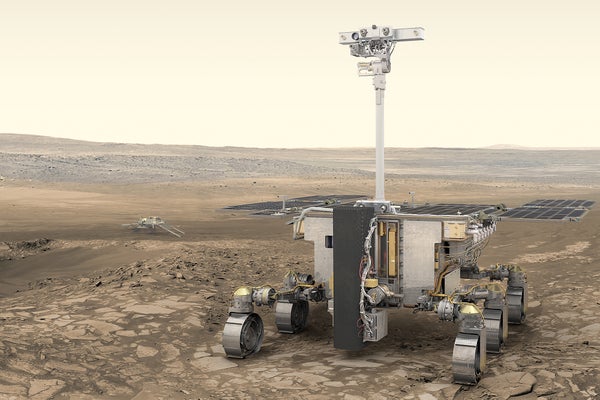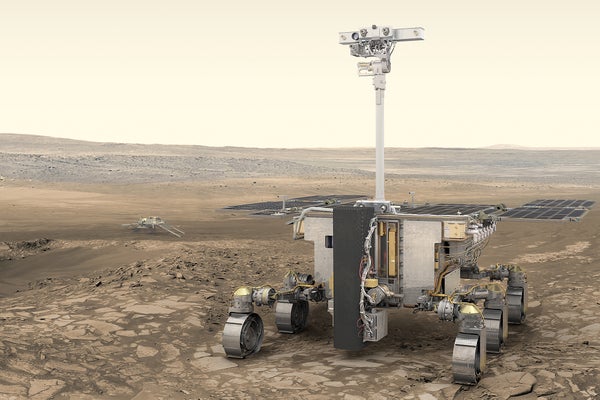Europe’s Mars Rover Will Use New Nuclear Power Source
The radioactive unit will help to deliver Europe’s first Mars rover to the planet’s surface

An artist’s impression of ESA’s ExoMars rover, Rosalind Franklin.
Europe’s upcoming Mars mission will use a pioneering nuclear-powered device that harnesses the radioactive decay of americium to keep its components warm — a first for spacecraft.
The European Space Agency (ESA) announced the plans on 16 May, alongside details of an agreement with NASA that crystallized the US agency’s contribution to the long-delayed mission, which will deliver Europe’s first Mars rover, called Rosalind Franklin. ESA was originally working with Russian space agency Roscosmos on the mission, but cancelled the partnership in 2022 after Russia invaded Ukraine.
Devices that harness the heat produced by the decay of radioactive elements, known as radioisotope heater units (RHUs), allow spacecraft to operate without relying on electricity generated by solar panels to warm them. ESA has historically relied on US or Russian partners to provide RHUs that use plutonium-238 for missions, but since 2009 has been working on its own programme to create radioisotope heaters, as well as batteries that provide electricity.
On supporting science journalism
If you’re enjoying this article, consider supporting our award-winning journalism by subscribing. By purchasing a subscription you are helping to ensure the future of impactful stories about the discoveries and ideas shaping our world today.
The European RHUs will heat components in the mission’s landing platform, which deploys the rover onto the Martian surface. The lander powers the rover before it exits the platform and opens its solar panels. So extending the lander’s life provides back up in case there are issues in deploying the rover, says Orson Sutherland, ESA’s group leader for Mars Exploration, based at the European Space Research and Technology Center (ESTEC) in Noordwijk, the Netherlands.
Americium decay
ESA’s heater units will not only be a first for Europe, but the first anywhere to use americium-241, a by-product of plutonium decay that packs less power per gram than its predecessor. But americium-241 is more abundant and cheaper, meaning that even if the RHUs require more of the isotope to run, they might be less expensive overall. “Developing and launching a European RHU will be a first for ESA and a major achievement,” says Sutherland.
The Rosalind Franklin rover is uniquely equipped to search for traces of ancient life on Mars, with a 2-metre drill that allows it to burrow deep beneath the Martian surface. But the mission was originally slated for launch in 2018 and had already been delayed by technical issues and the COVID-19 pandemic even before tensions escalated with Russia.
ESA had to radically rethink the mission to proceed without the involvement of Roscosmos, which was meant to build the lander. That led ESA to create a new European-designed lander and rely on NASA to fill the remaining holes in the mission plan. According to the agreement, NASA will provide capacity to launch ExoMars in 2028, as well as provide braking engines for the lander. NASA will also provide radioisotope heater units for the rover.
Future batteries
The americium RHUs are being created as part of the European Devices Using Radioisotope Energy (ENDURE) project. Because the devices contain radioactive materials, they require certification ahead of launch. The collaboration is working on fulfilling launch-safety requirements in time for 2028, says Richard Ambrosi, a physicist and specialist in space-power systems at the University of Leicester, part of the UK-based team leading development of the device.
By the end of the decade, ENDURE aims to have developed americium batteries capable of providing electricity to a spacecraft rather than just heat, in time for a series of ESA Moon missions in the early 2030s. While an RHU uses the heat naturally produced by radioactive decay, a nuclear battery — known as a radioisotope thermoelectric generator — converts that heat into electrical power.
The National Nuclear Laboratory, based in Sellafield, UK, will create the americium pellets needed for the heaters and batteries from spent nuclear fuel from the civil UK power plants.
ESA having its own heating units will allow the agency to expand its exploration horizon, says Sutherland. “The ability to keep flight systems warm in shaded areas, such as craters, or during the night will allow previously inaccessible areas to be explored and extend mission lifetime,” he says.
This article is reproduced with permission and was first published on May 21, 2024.







